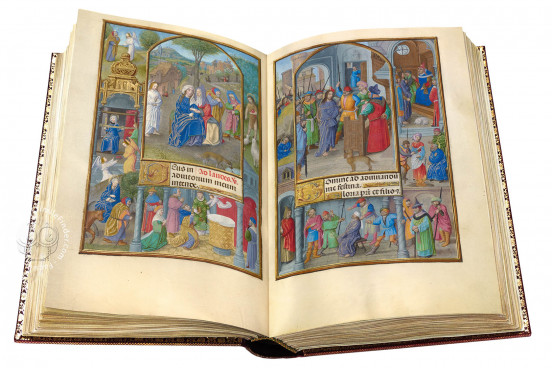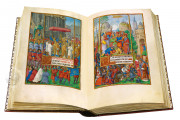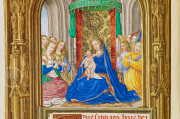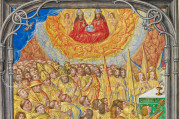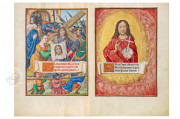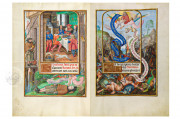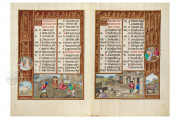Created around 1510-1520 in Ghent and Bruges, the Spinola Hours stands as the consummate representative of the quality, innovation, and ambition of sixteenth-century Flemish illumination. A deluxe Christian prayer book, it was illuminated by the most talented and admired, if anonymous, manuscript painters of their age. The Master of James IV of Scotland, who painted many of the miniatures and borders, may have coordinated the work of a team of at least six painters, including the Master of the Dresden Prayer Book, the Master of the Lübeck Bible, and the Master of the Prayer Books of around 1500.
The book is outstanding for the masterful illusionism of the painting and the sophisticated relationships between the miniatures and the surrounding painted borders. It boasts ten full-page miniatures, sixty-one three-quarter-page miniatures, and twelve bas-de-page calendar miniatures.
Many Artists, Single Vision
Although the painting has been attributed to four identifiable illuminators and to the workshop of yet another, the illumination is remarkably unified, all conceived with an exacting eye to symmetry across painted openings. Ambitious illusionism characterizes the treatment of both architectural settings and the flowers and birds of the strewn flower borders.
The program of illumination reveals a subtle hierarchy that reflects the book's textual contents. For example, seven of the eight illuminated openings in the Hours of the Virgin feature a scene from the life of the Virgin on the left and a scene from Christ's passion on the right. The very first, however, pairs the Annunciation to the Virgin with a miniature of the Miraculous Fleece of Gideon, which seems to share one landscape setting with Moses and the Burning Bush in the border (fols. 92v-93r). Both are Old Testament events understood to presage the virgin birth of Christ.
Inside and Outside
Many of the historiated borders depict scenes set in spaces that appear to be outdoors, just beyond the miniature's interior. The page with the miniature of the Feast of Dives offers an unfolding narrative that moves from the outer margin, where the poor man Lazarus approaches the house of the rich Dives, to the feast within the house in the miniature, to the soul of Lazarus carried by angels to heaven in the lower margin (fol. 21v).
Suspended Text
Most of the full-page miniatures feature text presented on fictive panels or scrolls. Some are integrated into the surrounding scene's fiction, such as the panels that appear to be held aloft by angels in the facing pair of miniatures of All Saints (fol. 39v-40r). Others emphasize the surface of the page, such as the scrolls that appear to be pinned to the pages of the facing miniatures of the Trinity and Abraham and the Three Angels (fols. 31v-32r).
Strewn Flower Borders
The text is written in Gothic Textualis in long lines (a single column), and the decorated initials that mark the beginnings of new texts are of delicate gold foliate forms on colored grounds. Most of the borders are of the strewn flower type, with illusionistic flowers and birds that appear to cast shadows on colored backgrounds.
Named for Its Eighteenth-Century Owner
The manuscript is named for the Genoese Spinola family, whose gold-tooled coat of arms appears on the front and back covers of its eighteenth-century binding of red morocco over pasteboard. Peter and Irene Ludwig acquired the book after 1976. The Ludwig collection of illuminated manuscripts was purchased by the J. Paul Getty Museum in 1983.
We have 1 facsimile edition of the manuscript "Spinola Hours": Spinola-Stundenbuch facsimile edition, published by Quaternio Verlag Luzern, 2026
Request Info / Price
